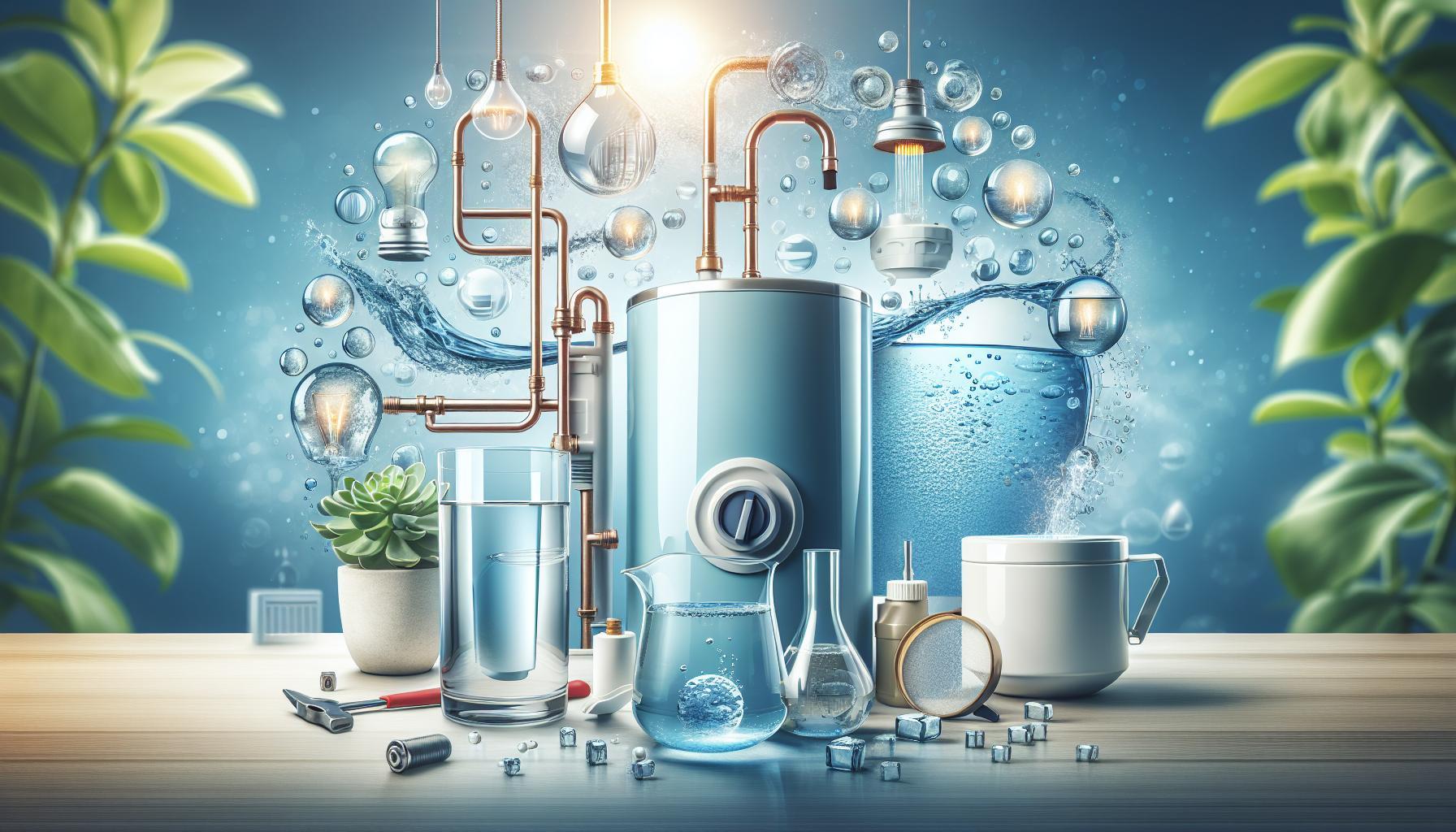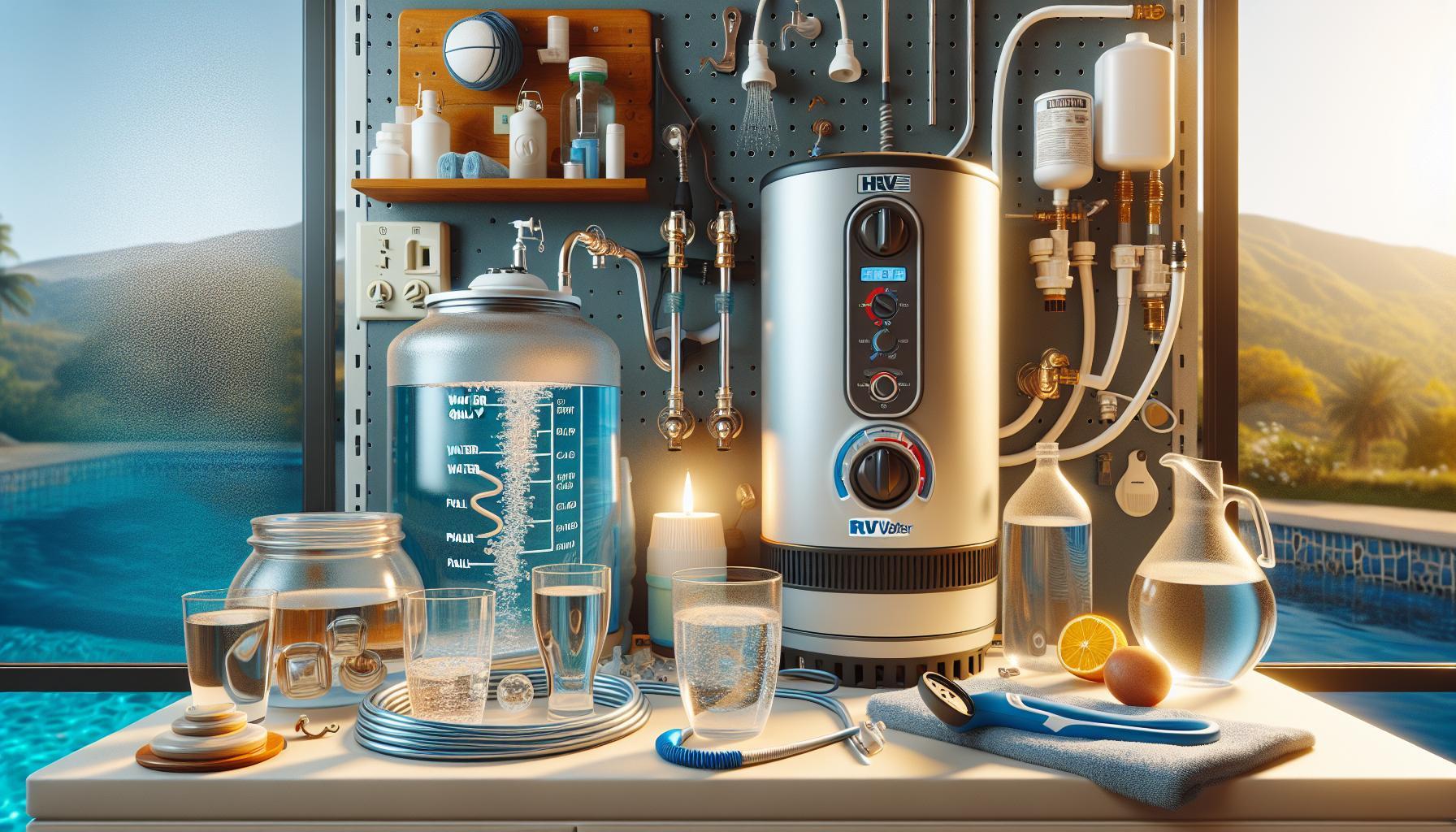As homeowners seek to optimize their plumbing systems, the question of whether a thermal expansion tank is necessary for a water heater looms large. Understanding the requirements set by local codes and the benefits such a tank offers is crucial for maintaining safety and efficiency. This article delves into why not having an expansion tank could lead to pressure issues and potential damage, while highlighting its importance in a closed water system.
Understanding the Purpose of an Expansion Tank in Water Heaters
Maintaining a safe and efficient water heating system is crucial for homeowners, and understanding the role of components like expansion tanks is key. When water is heated in a closed system, it expands, increasing pressure within the pipes and water heater. This can lead to potential damage, including burst pipes and water leaks. The installation of an expansion tank is a preventative measure that alleviates this pressure build-up, providing a designated space for the expanding water to flow without compromising the integrity of your plumbing system.
What is an Expansion Tank?
An expansion tank is a small tank that absorbs the excess pressure generated by thermal expansion. Typically installed in line with your water heater, it allows the expanding water to move into it, thereby regulating the overall pressure in the system. This component is particularly essential in systems lacking a natural expansion area, such as when a check valve or pressure-reducing valve is present, creating a closed plumbing system.
- Prevents Pipe Damage: By accommodating thermal expansion, the tank reduces the risk of burst pipes and leaks.
- Maintains System Efficiency: A properly functioning expansion tank helps maintain consistent water pressure, which can improve energy efficiency.
- Extends the Life of Appliances: By minimizing pressure spikes, it can prolong the lifespan of your water heater and plumbing fixtures.
Importance of Compliance with Local Codes
Compliance with local plumbing codes is crucial when considering whether an expansion tank is required for your water heater. Many jurisdictions mandate that thermal expansion tanks be installed in closed systems, as they significantly mitigate risks associated with increased water pressure. Homeowners should refer to their local regulations to ensure proper installation and adherence to safety standards, which not only protects your home but can also enhance insurance coverage in the event of plumbing failures.
| Advantages of Installing an Expansion Tank | Potential Risks of Not Installing |
|---|---|
| Absorbs excess pressure | Increased risk of leaks and bursts |
| Protects plumbing fixtures | Higher repair costs |
| Improves water pressure stability | Potential system failures |
| Ensures compliance with codes | Legal and insurance complications |
In summary, not only does an expansion tank serve as a critical component in managing the complexities of a water heating system, but it also fulfills necessary safety codes and regulations. Investing in an expansion tank is a proactive approach that protects both your property and plumbing system while enhancing overall efficiency. Understanding its purpose is essential for anyone looking to maintain a healthy and compliant home plumbing system.
Key Building Codes Regarding Water Heater Expansion Tanks

When considering the installation or upgrading of a water heater, understanding relevant building codes regarding expansion tanks is crucial. Expansion tanks, which are designed to accommodate the increased pressure in a closed water heating system, are often mandated by various codes to prevent damage to plumbing fixtures, water heaters, and the overall plumbing system. Depending on your local jurisdiction, codes may specify when an expansion tank is required, what size and type to install, and the proper location for installation.
Understanding Code Requirements
Local building codes typically refer to standards established by authorities such as the International Plumbing Code (IPC) or the National Fire Protection Association (NFPA). The specifics can vary, but generally, the key points in building codes concerning expansion tanks include:
- Required Installation: In many areas, an expansion tank is required when a water heater is connected to a closed water supply system. This is especially true for systems with backflow preventers or pressure-reducing valves.
- Placement: The code usually specifies that the expansion tank must be installed on the cold water line feeding the water heater, as close to the heater as possible.
- Size Specifications: The required size of an expansion tank often depends on the volume of the water heater and the overall system pressure, which is detailed in various code documents.
Benefits of Compliance
Complying with these codes not only ensures safety and efficiency but also protects homeowners from costly repairs. For instance, inadequate pressure management can lead to burst pipes or damage to the water heater itself. By following the code and installing an expansion tank, homeowners can effectively manage the thermal expansion and potential pressure surges that occur when the water heats up.
Moreover, adhering to local codes often simplifies the inspection process and may be necessary for insurance coverage. Many insurance providers require compliance with local building codes to avoid disputes related to water damage claims. It is advisable for homeowners to consult with a licensed plumber or contractor who understands these codes, ensuring that any installation meets both local regulations and safety standards.
In summary, knowing whether an expansion tank is required for your water heater—and the pertinent building codes surrounding its installation—is vital. This diligence not only enhances the longevity of your plumbing system but also assures peace of mind for homeowners by preventing unexpected issues related to pressure and safety.
How Expansion Tanks Work to Prevent Plumbing Issues

The importance of expansion tanks in maintaining the integrity of plumbing systems cannot be overstated. These units serve a vital purpose in managing pressure changes within water heater systems, thereby preventing costly leaks and damage. When water heats up, it expands; without a designated space to accommodate this expansion, pressure can build up to dangerous levels. An expansion tank acts as a buffer, absorbing excess pressure and ensuring a stable water flow throughout your home. Understanding how these components function can help homeowners appreciate their value and recognize the necessity of compliance with local plumbing codes.
How Expansion Tanks Function
An expansion tank typically consists of a small, pre-pressurized chamber that divides hot water from cold water using a flexible diaphragm. When water is heated, the pressure inside the system rises; the expansion tank allows this excess pressure to be diverted into its chamber instead of causing stress on the water heater or plumbing fixtures. This immediate response helps to:
- Protect plumbing infrastructure: By stabilizing pressure, expansion tanks minimize the potential for leaks in joints and fixtures, which can lead to significant repair costs.
- Extend the lifespan of water heaters: Consistent and controlled pressure reduces wear and tear, enabling water heaters to function optimally for a longer time.
- Increase efficiency: A properly functioning expansion tank helps maintain consistent water pressure, ensuring efficient operation of appliances such as dishwashers and washing machines.
The necessity of an expansion tank is often governed by local plumbing codes, especially in systems that exhibit high pressure due to thermal expansion. For instance, the Uniform Plumbing Code (UPC) and the International Plumbing Code (IPC) mandate the installation of expansion tanks in residential plumbing systems. Homeowners should check local regulations to ensure compliance, as this not only ensures safety but also protects the property from future plumbing issues.
Signs Your Expansion Tank Is Failing
While expansion tanks can prevent many plumbing issues, they are not immune to failure. Common signs include:
- Visible leaks around the tank
- Unusual noise coming from the plumbing system
- Inconsistent water pressure
- Frequent water heater issues
Being aware of these warning signs can help homeowners take action before minor issues escalate into major repairs. Regular maintenance checks and timely replacement of faulty tanks are crucial steps in safeguarding the plumbing system and ensuring compliance with the standards detailed in articles discussing whether an expansion tank is required for a water heater, including their codes and benefits.
Benefits of Installing an Expansion Tank for Your Water Heater
Installing an expansion tank for your water heater can significantly enhance the efficiency and safety of your plumbing system. As the water heats up, it expands, creating pressure that can lead to a range of plumbing issues, from nuisance leaks to costly repairs. By incorporating an expansion tank, homeowners can effectively manage this pressure, ensuring their systems operate smoothly.
Key Benefits
- Pressure Regulation: Expansion tanks act as a buffer that absorbs the increased pressure from heated water, preventing damage to the water heater and plumbing system. This regulation is essential for avoiding dangerous pressure spikes that can lead to leaks or ruptures.
- Extended Lifespan: By minimizing the stress on your plumbing components, expansion tanks contribute to a longer lifespan for your water heater and pipes. Fewer pressure-related issues mean less wear and tear over time.
- Code Compliance: Many local plumbing codes now require the installation of expansion tanks for new water heaters. Compliance not only ensures safety but can also be beneficial for resale value.
- Energy Efficiency: Maintaining stable pressure can improve the efficiency of your water heating system, potentially leading to lower energy bills. When pressure is balanced, water is heated more uniformly.
Real-World Example
Consider a typical household where the water heater is located in a closed plumbing system. Without an expansion tank, the pressure from heating water might exceed the safe limits, resulting in a burst pipe or a failing water heater. In contrast, homes equipped with expansion tanks report fewer plumbing emergencies and lower maintenance costs. This practical addition not only protects your investment but also provides peace of mind.
In conclusion, the extend far beyond simple functionality; they play a crucial role in maintaining the integrity of your entire plumbing system. Whether you are looking to comply with local codes or seeking to enhance your home’s efficiency, adding an expansion tank is a smart choice for long-term savings and safety.
Signs That You Might Need an Expansion Tank
Understanding the importance of an expansion tank can be crucial for maintaining a safe and efficient plumbing system. As water heats in your heater, it expands, creating pressure within your water heater and plumbing. When this pressure becomes excessive, it can lead to leaks, bursts, or even the failure of your water heater. Here are some key signs that indicate you might need an expansion tank.
Unusual Pressure Changes
If you notice fluctuations in water pressure in your home, it could suggest that your plumbing system is not equipped to handle the thermal expansion caused by your water heater. This issue often manifests as an inconsistent flow of water from taps or appliances. If you frequently experience surges in pressure or a decrease in water flow, installing an expansion tank may be advisable.
Water Heater Leaks
A leaking water heater is often a direct warning sign that the pressure within the tank is too high. Check for moisture or drips around the base of your water heater; excessive pressure may force water out of the tank or fittings. If you notice these leaks, it’s time to investigate the performance of your expansion tank as well as considering its installation if one isn’t currently present.
Water Hammer
The phenomenon known as water hammer occurs when the flow of water is suddenly stopped, causing a loud banging noise in your pipes. This problem can be exacerbated by high water pressure, typically indicating the need for an expansion tank. Installing one can help absorb the shock and prevent noise, preserving the integrity of your plumbing.
Age of Your Current Expansion Tank
If your home already has an expansion tank, consider its age. Most expansion tanks have a lifespan of 5 to 7 years, after which their efficacy may diminish. A regular inspection can help determine whether it’s time for a replacement, particularly if you notice any signs of rust or corrosion.
Recognizing these signs can save you from costly repairs and the headaches associated with plumbing malfunctions. Regular maintenance and installation of an expansion tank not only meets local code requirements but also enhances the longevity and safety of your water heater system.
Common Misconceptions About Expansion Tanks and Water Heaters
Misunderstandings about expansion tanks and their role in a home’s plumbing system are more common than you might think. Many homeowners are uncertain about whether an expansion tank is necessary for a water heater and the tangible benefits it provides. Essentially, an expansion tank is a crucial component in preventing pressure build-up within a closed water system, especially when there’s a water heater involved. Without one, homeowners may experience issues such as water hammer, leaks, or even ruptured pipes.
One prevalent misconception is that expansion tanks are only necessary for larger water heaters or high-volume systems. In reality, any closed plumbing system—regardless of its size—can benefit from an expansion tank. When water heats up, it expands, and without a designated space to accommodate this increased volume, pressure can rise to dangerous levels. Proper installation of an expansion tank ensures that excess pressure is absorbed, safeguarding your plumbing system.
Additionally, some people believe that the presence of a pressure relief valve makes an expansion tank redundant. However, while a pressure relief valve can prevent some risks associated with high pressure, it might not react quickly enough to sudden surges in pressure caused by thermal expansion. An expansion tank helps to cushion these changes, leading to enhanced safety and longevity for your plumbing infrastructure.
To clarify further, the installation of an expansion tank is often mandated by local codes, particularly in closed systems. This regulation aims to protect not only the home’s plumbing but also the structural integrity of the water heater itself. Neglecting to install an expansion tank can lead to costly repairs and potential hazards. Understanding these facts can empower homeowners to make informed decisions regarding their plumbing systems and ensure they take necessary precautions against pressure-related issues.
How to Properly Install and Maintain an Expansion Tank
Installing and maintaining an expansion tank is essential for ensuring the longevity and efficiency of your water heater system. These tanks play a crucial role in absorbing excess pressure caused by thermal expansion in a closed system, preventing potential damage to pipes and the water heater itself. To achieve optimal performance and compliance with local codes, it’s important to follow proper installation techniques and maintenance routines.
Installation Steps
When preparing to install an expansion tank, gather the necessary tools such as wrenches, pipe cutters, and Teflon tape. The installation should occur in an accessible location on the cold water supply line to the water heater. Here are key steps to follow:
- Turn Off the Water Heater: Before starting, make sure to turn off the water heater and shut off the cold water supply.
- Drain the Line: Open a faucet to relieve pressure and drain the existing water in the line.
- Find Suitable Space: Identify a space near the water heater where the expansion tank can be mounted. It should be installed vertically, ideally 18 inches away from the water heater.
- Cut the Pipe: Use a pipe cutter to cut the cold water supply line where the expansion tank will be installed.
- Install Fittings and the Tank: Attach the necessary fittings and connect the expansion tank. Ensure all connections are tight and sealed with Teflon tape to prevent leaks.
- Restore Water Supply: Once the connections are secure, restore the water supply and check for leaks.
Installing an expansion tank correctly ensures compliance with plumbing codes and provides the benefits outlined in discussions about whether an expansion tank is required for a water heater.
Maintenance Tips
Regular maintenance of your expansion tank is vital to ensure its functional integrity. Here are some actionable steps to keep it running efficiently:
- Check the Air Pressure: Periodically, check the air pressure in the tank using a tire pressure gauge. The recommended pressure is typically around 50% of the incoming water pressure. Adjust as necessary by using a bicycle pump.
- Inspect for Water Damage: Look for signs of leaks or corrosion around the tank. If you find water accumulation, it’s crucial to investigate further.
- Monitor System Performance: Keep an eye on your water heater’s performance. If you notice fluctuations in water temperature or pressure, it may indicate an issue with the expansion tank.
- Schedule Professional Inspections: Consider having a plumber inspect the expansion tank periodically, particularly if your home has older plumbing or if you notice any irregularities.
By properly installing and maintaining your expansion tank, you can enhance the efficiency of your heating system, mitigate risks of plumbing damage, and adhere to the code requirements discussed concerning expansion tanks’ necessity for water heaters.
Q&A
Is an Expansion Tank Required for a Water Heater? Code and Benefits?
Yes, an expansion tank is generally required for water heaters by residential codes, including the International Residential Code (IRC P2903.4). This requirement helps manage the pressure fluctuations caused by water heating.
When water is heated, it expands and can increase pressure within plumbing systems. An expansion tank provides a safe space for this expanding hot water. By absorbing the extra pressure, these tanks help prevent damage to pipes, fittings, and the water heater itself.
What Are the Benefits of Installing an Expansion Tank?
Installing an expansion tank can significantly prolong the life of your water heater by reducing stress on the system. It also minimizes the risk of leaks and burst pipes as pressure is controlled.
An expansion tank allows hot water to expand without causing excessive pressure in your plumbing. This is particularly vital in closed-loop systems, where the water cannot flow back to the supply line. Preventive measures like this enhance the safety and efficiency of your plumbing system.
Why Does My Water Heater Need an Expansion Tank?
A water heater needs an expansion tank to accommodate the thermal expansion of water when heated, preventing pressure-related issues in plumbing systems.
When your water heater heats water, it expands, and without a designated area for this expansion, pressure can build up and potentially cause plumbing problems. The expansion tank absorbs the increased pressure, making it a crucial component especially in newer homes with closed systems.
Can I Install an Expansion Tank Myself?
Yes, you can install an expansion tank yourself if you have basic plumbing skills. However, proper installation is crucial for effectiveness.
Follow the manufacturer’s instructions carefully to ensure the tank is positioned correctly within the system. If your experience is limited or local codes require permits, it might be wise to hire a professional plumber to safely install the tank.
What Happens If I Don’t Install an Expansion Tank?
Not installing an expansion tank can lead to increased pressure in the plumbing, resulting in potential damage, leaks, or even burst pipes.
Without this safety feature, your plumbing system may experience excessive stress due to pressure fluctuations, leading to costly repairs. Over time, this can shorten the lifespan of your water heater and other plumbing fixtures, making it an unwise choice to skip this installation.
Are Expansion Tanks Required by Local Code?
Yes, many local codes require expansion tanks due to the risks of pressure build-up. Always check your local plumbing codes.
For instance, the International Residential Code mandates expansion tanks particularly in closed plumbing systems. However, variations might exist depending on your state or municipality. Confirming local requirements can save you from potential fines or unsafe conditions.
How Do I Know If My Water Heater Needs an Expansion Tank?
If your water heater is connected to a closed plumbing system or you notice fluctuating water pressure, it likely needs an expansion tank.
In older homes or those without expansion tanks, it’s wise to evaluate your system. Consulting a plumber can provide insights into whether an expansion tank could benefit your specific setup. Regular maintenance checks can also reveal pressure issues before they escalate.
In Summary
In conclusion, a water heater expansion tank is not just a luxury—it’s often a necessity for maintaining the integrity of your plumbing system. By accommodating the thermal expansion of water, these tanks help alleviate pressure on your pipes and water heater, reducing the risk of damage and costly repairs. Depending on local plumbing codes, having an expansion tank may be a requirement, so it’s essential to check your area’s regulations. The benefits of installing an expansion tank extend beyond compliance—it promotes longevity and efficiency in your home’s plumbing. We encourage you to delve deeper into the specifics of expansion tanks, consider your own plumbing needs, and explore the potential cost savings of proper installation and maintenance. For more insights and guidance on managing your home’s water systems, don’t hesitate to reach out and empower your understanding of these crucial components.






